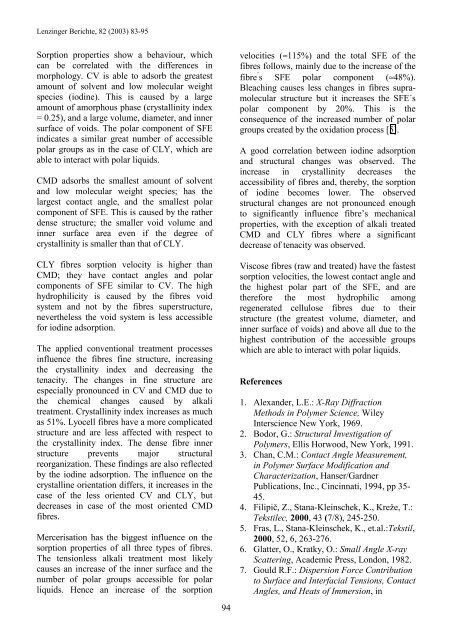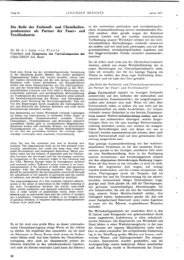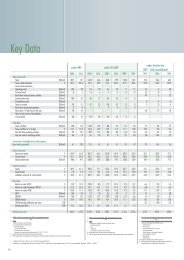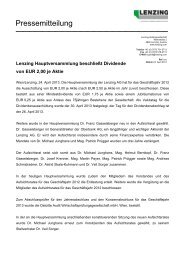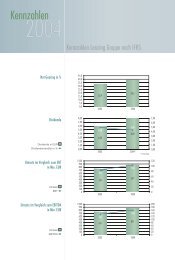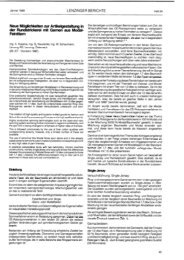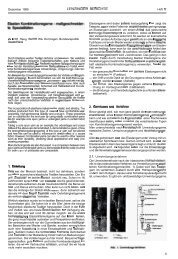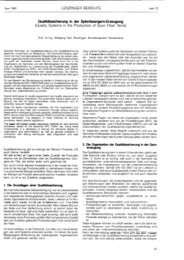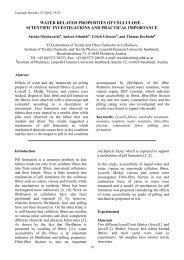Correlation of regenerated fibres morphology and surface ... - Lenzing
Correlation of regenerated fibres morphology and surface ... - Lenzing
Correlation of regenerated fibres morphology and surface ... - Lenzing
You also want an ePaper? Increase the reach of your titles
YUMPU automatically turns print PDFs into web optimized ePapers that Google loves.
<strong>Lenzing</strong>er Berichte, 82 (2003) 83-95<br />
Sorption properties show a behaviour, which<br />
can be correlated with the differences in<br />
<strong>morphology</strong>. CV is able to adsorb the greatest<br />
amount <strong>of</strong> solvent <strong>and</strong> low molecular weight<br />
species (iodine). This is caused by a large<br />
amount <strong>of</strong> amorphous phase (crystallinity index<br />
= 0.25), <strong>and</strong> a large volume, diameter, <strong>and</strong> inner<br />
<strong>surface</strong> <strong>of</strong> voids. The polar component <strong>of</strong> SFE<br />
indicates a similar great number <strong>of</strong> accessible<br />
polar groups as in the case <strong>of</strong> CLY, which are<br />
able to interact with polar liquids.<br />
CMD adsorbs the smallest amount <strong>of</strong> solvent<br />
<strong>and</strong> low molecular weight species; has the<br />
largest contact angle, <strong>and</strong> the smallest polar<br />
component <strong>of</strong> SFE. This is caused by the rather<br />
dense structure; the smaller void volume <strong>and</strong><br />
inner <strong>surface</strong> area even if the degree <strong>of</strong><br />
crystallinity is smaller than that <strong>of</strong> CLY.<br />
CLY <strong>fibres</strong> sorption velocity is higher than<br />
CMD; they have contact angles <strong>and</strong> polar<br />
components <strong>of</strong> SFE similar to CV. The high<br />
hydrophilicity is caused by the <strong>fibres</strong> void<br />
system <strong>and</strong> not by the <strong>fibres</strong> superstructure,<br />
nevertheless the void system is less accessible<br />
for iodine adsorption.<br />
The applied conventional treatment processes<br />
influence the <strong>fibres</strong> fine structure, increasing<br />
the crystallinity index <strong>and</strong> decreasing the<br />
tenacity. The changes in fine structure are<br />
especially pronounced in CV <strong>and</strong> CMD due to<br />
the chemical changes caused by alkali<br />
treatment. Crystallinity index increases as much<br />
as 51%. Lyocell <strong>fibres</strong> have a more complicated<br />
structure <strong>and</strong> are less affected with respect to<br />
the crystallinity index. The dense fibre inner<br />
structure prevents major structural<br />
reorganization. These findings are also reflected<br />
by the iodine adsorption. The influence on the<br />
crystalline orientation differs, it increases in the<br />
case <strong>of</strong> the less oriented CV <strong>and</strong> CLY, but<br />
decreases in case <strong>of</strong> the most oriented CMD<br />
<strong>fibres</strong>.<br />
Mercerisation has the biggest influence on the<br />
sorption properties <strong>of</strong> all three types <strong>of</strong> <strong>fibres</strong>.<br />
The tensionless alkali treatment most likely<br />
causes an increase <strong>of</strong> the inner <strong>surface</strong> <strong>and</strong> the<br />
number <strong>of</strong> polar groups accessible for polar<br />
liquids. Hence an increase <strong>of</strong> the sorption<br />
94<br />
velocities (≈115%) <strong>and</strong> the total SFE <strong>of</strong> the<br />
<strong>fibres</strong> follows, mainly due to the increase <strong>of</strong> the<br />
fibre ’ s SFE polar component (≈48%).<br />
Bleaching causes less changes in <strong>fibres</strong> supramolecular<br />
structure but it increases the SFE´s<br />
polar component by 20%. This is the<br />
consequence <strong>of</strong> the increased number <strong>of</strong> polar<br />
groups created by the oxidation process [5].<br />
A good correlation between iodine adsorption<br />
<strong>and</strong> structural changes was observed. The<br />
increase in crystallinity decreases the<br />
accessibility <strong>of</strong> <strong>fibres</strong> <strong>and</strong>, thereby, the sorption<br />
<strong>of</strong> iodine becomes lower. The observed<br />
structural changes are not pronounced enough<br />
to significantly influence fibre’s mechanical<br />
properties, with the exception <strong>of</strong> alkali treated<br />
CMD <strong>and</strong> CLY <strong>fibres</strong> where a significant<br />
decrease <strong>of</strong> tenacity was observed.<br />
Viscose <strong>fibres</strong> (raw <strong>and</strong> treated) have the fastest<br />
sorption velocities, the lowest contact angle <strong>and</strong><br />
the highest polar part <strong>of</strong> the SFE, <strong>and</strong> are<br />
therefore the most hydrophilic among<br />
<strong>regenerated</strong> cellulose <strong>fibres</strong> due to their<br />
structure (the greatest volume, diameter, <strong>and</strong><br />
inner <strong>surface</strong> <strong>of</strong> voids) <strong>and</strong> above all due to the<br />
highest contribution <strong>of</strong> the accessible groups<br />
which are able to interact with polar liquids.<br />
References<br />
1. Alex<strong>and</strong>er, L.E.: X-Ray Diffraction<br />
Methods in Polymer Science, Wiley<br />
Interscience New York, 1969.<br />
2. Bodor, G.: Structural Investigation <strong>of</strong><br />
Polymers, Ellis Horwood, New York, 1991.<br />
3. Chan, C.M.: Contact Angle Measurement,<br />
in Polymer Surface Modification <strong>and</strong><br />
Characterization, Hanser/Gardner<br />
Publications, Inc., Cincinnati, 1994, pp 35-<br />
45.<br />
4. Filipič, Z., Stana-Kleinschek, K., Kreže, T.:<br />
Tekstilec, 2000, 43 (7/8), 245-250.<br />
5. Fras, L., Stana-Kleinschek, K., et.al.:Tekstil,<br />
2000, 52, 6, 263-276.<br />
6. Glatter, O., Kratky, O.: Small Angle X-ray<br />
Scattering, Academic Press, London, 1982.<br />
7. Gould R.F.: Dispersion Force Contribution<br />
to Surface <strong>and</strong> Interfacial Tensions, Contact<br />
Angles, <strong>and</strong> Heats <strong>of</strong> Immersion, in


